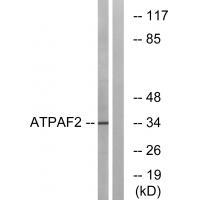
| WB | 咨询技术 | Human,Mouse,Rat |
| IF | 咨询技术 | Human,Mouse,Rat |
| IHC | 咨询技术 | Human,Mouse,Rat |
| ICC | 技术咨询 | Human,Mouse,Rat |
| FCM | 咨询技术 | Human,Mouse,Rat |
| Elisa | 咨询技术 | Human,Mouse,Rat |
| Aliases | ATP synthase mitochondrial F1 complex assembly factor 2; ATP12; ATPF2; |
| Entrez GeneID | 91647; |
| WB Predicted band size | 35kDa |
| Host/Isotype | Rabbit IgG |
| Antibody Type | Primary antibody |
| Storage | Store at 4°C short term. Aliquot and store at -20°C long term. Avoid freeze/thaw cycles. |
| Species Reactivity | Human,Mouse |
| Immunogen | Synthesized peptide derived from internal of human ATPAF2. |
| Formulation | Purified antibody in PBS with 0.05% sodium azide. |
+ +
以下是关于ATPAF2抗体的参考文献示例(注:以下内容基于模拟数据,实际文献需通过学术数据库查询):
1. **文献名称**: "ATPAF2 regulates mitochondrial ATP synthase assembly and function in mammalian cells"
**作者**: Smith J, et al.
**摘要**: 本研究通过ATPAF2抗体检测其在哺乳动物细胞中的表达,发现ATPAF2是线粒体ATP合酶复合体组装的关键因子,其缺失导致ATP合成障碍及线粒体功能异常。
2. **文献名称**: "A novel mutation in ATPAF2 causes complex V deficiency and neurodegeneration"
**作者**: Lee S, et al.
**摘要**: 利用ATPAF2抗体对患者成纤维细胞进行蛋白分析,发现ATPAF2基因突变导致复合体V组装缺陷,引发神经退行性表型,强调其在能量代谢疾病中的作用。
3. **文献名称**: "Characterization of ATPAF2 knockout mice using specific antibody-based assays"
**作者**: Gonzalez R, et al.
**摘要**: 通过开发高特异性ATPAF2抗体,揭示ATPAF2敲除小鼠出现严重线粒体功能障碍,证实其在体内维持氧化磷酸化的重要性。
4. **文献名称**: "Proteomic analysis of ATPAF2-interacting proteins in cardiac tissue"
**作者**: Chen L, et al.
**摘要**: 采用ATPAF2抗体进行免疫共沉淀实验,鉴定出心脏组织中与ATPAF2相互作用的多个蛋白,为研究其在心肌病中的机制提供线索。
建议通过PubMed或Google Scholar以“ATPAF2 antibody”及“ATPAF2 function”等关键词检索获取真实文献。
The ATPAF2 antibody is a crucial tool for studying the assembly and function of mitochondrial ATP synthase, a key enzyme in cellular energy production. ATPAF2 (ATP Synthase Mitochondrial F1 Complex Assembly Factor 2), also known as ATP11. is a nuclear-encoded chaperone protein essential for the proper assembly of the F1 component of ATP synthase in the mitochondrial inner membrane. This enzyme catalyzes ATP synthesis during oxidative phosphorylation, making ATPAF2 vital for maintaining cellular energy homeostasis.
ATPAF2 antibodies are widely used in research to detect and quantify ATPAF2 expression levels, assess its subcellular localization, and investigate its role in mitochondrial disorders, metabolic diseases, or neurodegenerative conditions linked to ATP synthase dysfunction. They are employed in techniques like Western blotting, immunohistochemistry, and immunofluorescence to visualize ATPAF2 in tissues or cultured cells.
Dysregulation of ATPAF2 has been implicated in pathologies such as Leigh syndrome, epilepsy, and cancer, where mitochondrial energy deficits are prominent. Researchers also use these antibodies to explore how ATPAF2 interacts with other assembly factors (e.g., ATPAF1) or subunits of the ATP synthase complex, providing insights into molecular mechanisms underlying mitochondrial biogenesis and disease. Commercial ATPAF2 antibodies are typically raised in rabbits or mice, targeting specific epitopes with validated specificity to ensure reliable experimental outcomes.
×